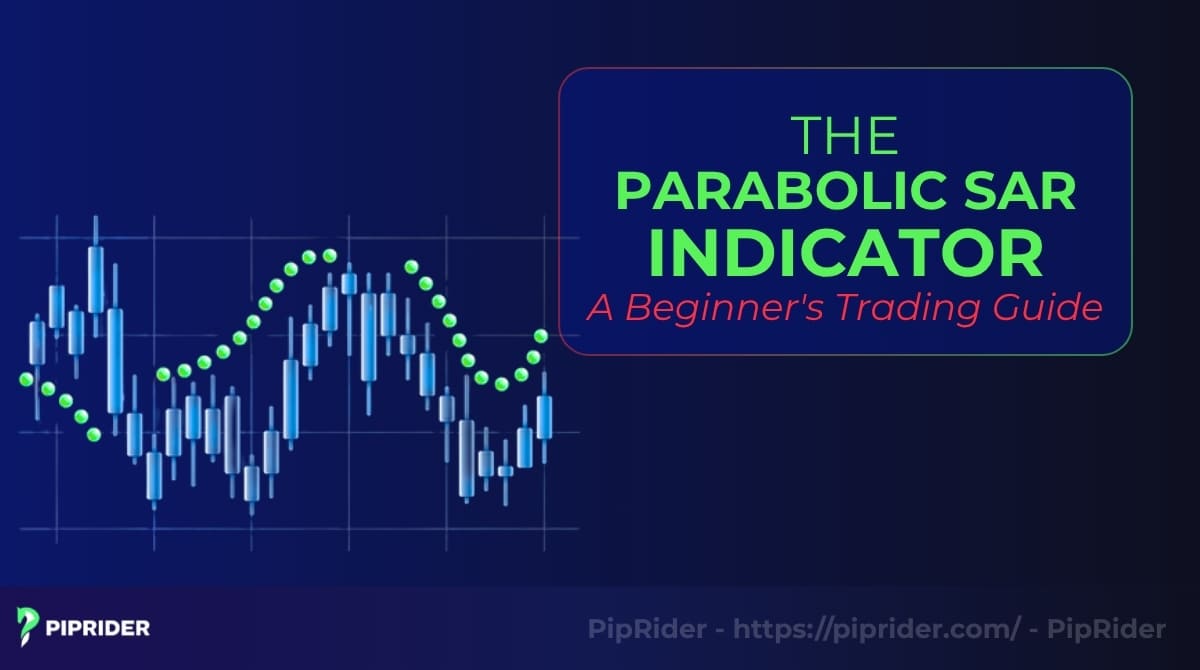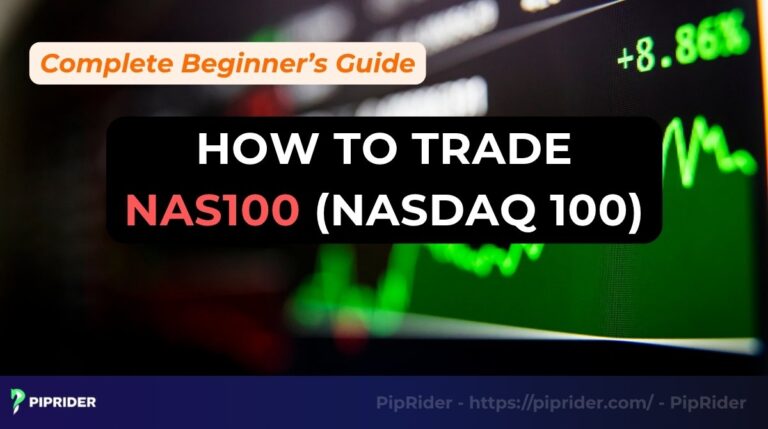The parabolic SAR indicator acts as a visual roadmap on your chart, using markers to pinpoint trend direction and signal potential reversals. For new traders, cutting through market noise is a huge challenge, and we know from experience that this tool is one of the best for bringing clarity to your decisions.
It’s more than just an indicator; it’s a system for following trends and protecting profits with a dynamic trailing stop-loss. This guide goes beyond textbook definitions to walk you through practical strategies, common mistakes, and how to combine the SAR with other tools for better results. Let’s start building your confidence today.
Key Takeaways
- The Parabolic SAR indicator uses a series of points to visually identify a market trend.
- A shift in a marker’s position signals a time to enter or exit a trade.
- It is a powerful tool for a trailing stop, helping to lock in profits as a trend continues.
- The indicator works most effectively in markets with clear, sustained trends.
- For greater accuracy, always combine the Parabolic SAR with other indicators to confirm signals.
1. What is the parabolic SAR indicator?
The Parabolic SAR (Stop and Reverse) is a widely recognized tool in technical analysis that helps traders assess market trends and pinpoint potential reversal points.
On a chart, its graphical representation is a series of dots positioned either above or below the price candles, providing clear visual cues for decision-making. Simply put, when the points are below the price, it suggests an uptrend. When they are positioned above the price, it indicates a downtrend.
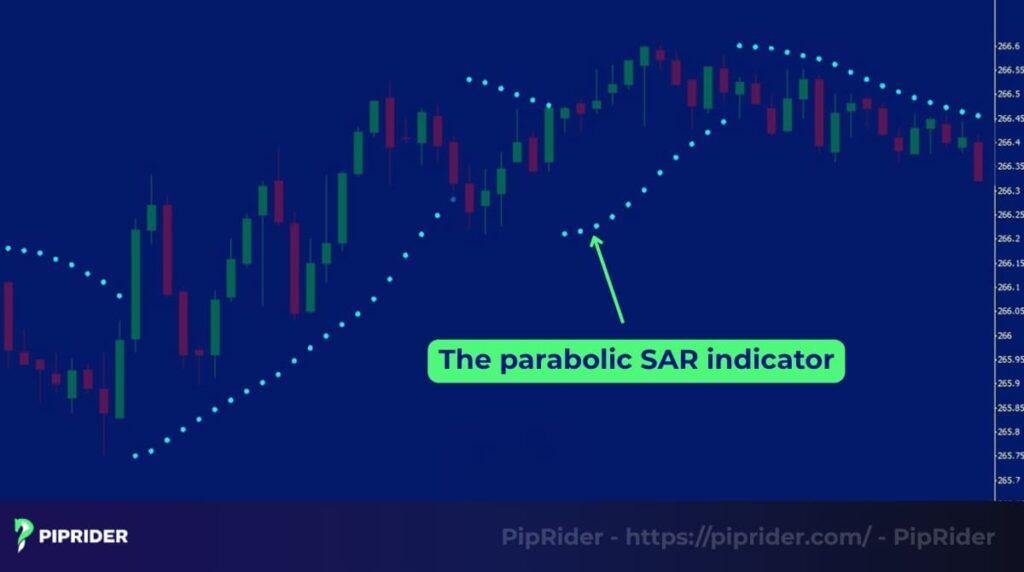
The SAR indicator was created by renowned technical analyst J. Welles Wilder Jr., the genius responsible for popular tools like the Relative Strength Index (RSI) and the Average Directional Index (ADX). He introduced it in his seminal 1978 book, New Concepts in Technical Trading Systems (Wilder, 1978).
The name “Parabolic Stop and Reverse” perfectly describes its primary functions. The tool is designed to:
- Follow a trend like a “stop” loss that trails the price movement.
- Signal when the trend has potentially ended and is ready to “reverse”.
Think of it as a built-in guide that helps you stay in a trade while the trend is strong and gives you a clear signal when it might be time to get out.
2. How does the parabolic SAR indicator work?
The SAR fundamentally functions by consistently determining a “stop” level for every timeframe displayed on your chart. This stop level is represented by the dot. The indicator’s movement is designed to accelerate towards the price as a trend develops, creating its signature “parabolic” curve (Fidelity, n.d.; Strike Money, n.d.).
From our own trading journey, the best way to understand this is to think of the SAR markers as a loyal companion following your price. When the price is walking uphill (an uptrend), this companion follows closely behind. When the price takes a sharp turn and starts to decline, the companion swiftly moves ahead to guide the path. The moment they switch positions is the signal that a shift in short-term momentum has occurred.
2.1. The core mechanism: Markers above vs. markers below
The indicator’s logic is elegantly simple and revolves around where the dots appear in relation to the price.
- When markers are below the price: The market is clearly in an uptrend. The SAR is in a bullish mode, and the points will keep moving higher as long as prices continue to reach new highs. Each new marker will be higher than the previous one, acting as a rising stop-loss to protect a long position.
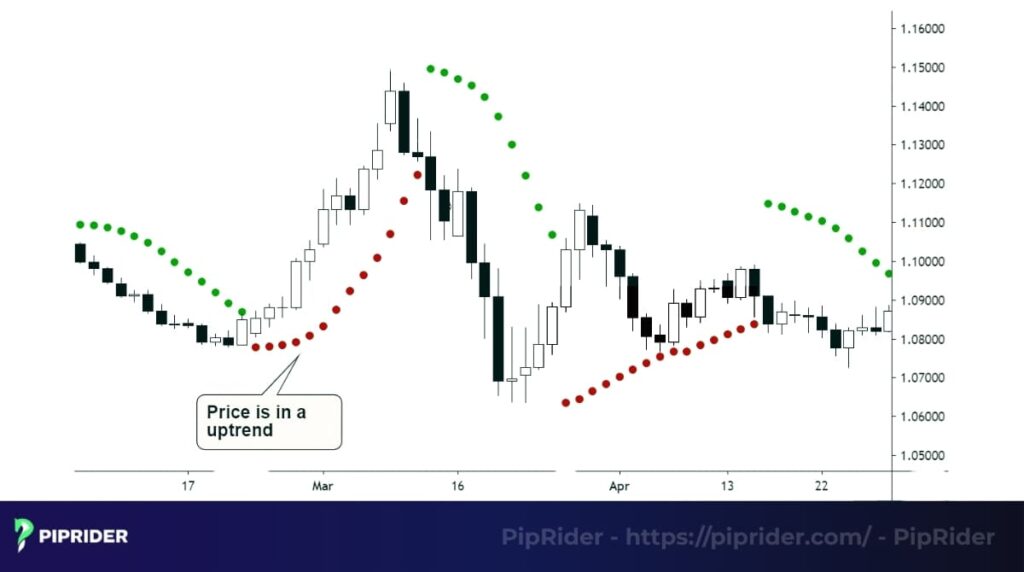
- When markers are above the price: It clearly indicates that the market is experiencing a downward trend. The SAR is in a bearish mode. The points will move lower as the price makes new lows, serving as a descending stop-loss for a short position.
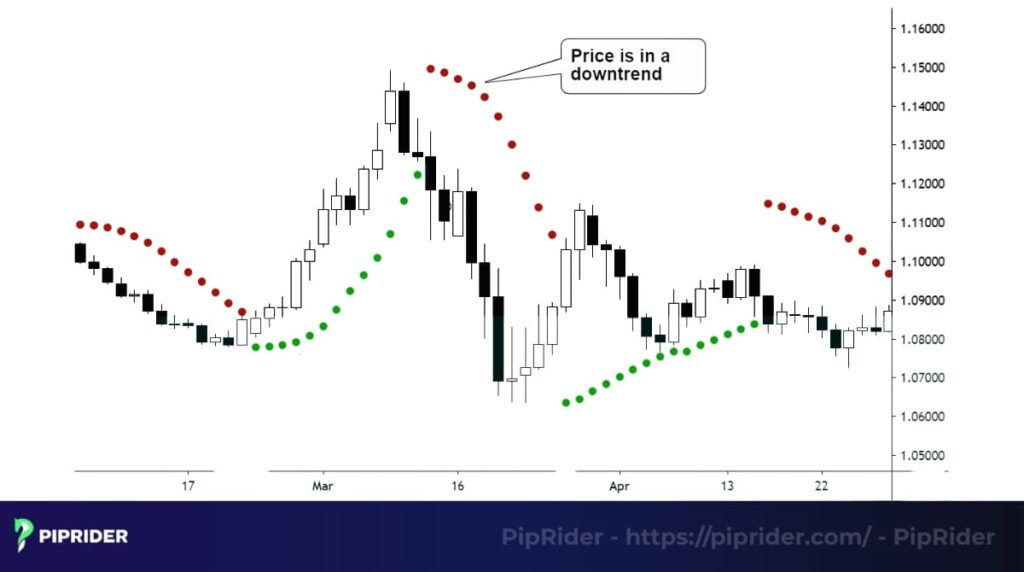
The chart shows that the magic happens when the price action touches or crosses a dot. This event is the “Stop and Reverse” (SAR) trigger. The indicator immediately flips to the other side of the price, signaling that the previous trend has likely ended and a new one is beginning.
In our experience, the speed at which the markers move towards the price is crucial. A young and strong trend features points that are spaced out, allowing the price ample room to maneuver. As the trend matures and the momentum begins to wane, those points move closer to the price, tightening the stop-loss and signaling an impending reversal.
2.2. How to read the parabolic SAR indicator
Reading the indicator on a live chart is straightforward once you know what to look for. Let’s break it down into actionable signals.
Identifying the Trend Direction
This is the most basic and immediate use. Simply look at your chart:
- Uptrend Signal: The dots consistently appear below the price candles, indicating an uptrend.
- Downtrend Signal: Conversely, when they consistently appear above the price candles, it’s a sign of a downtrend.
For example, if you’re looking at a GBP/JPY 1-hour chart and see a fresh series of markers appearing under the candles, the SAR is giving you a clear visual confirmation that buyers are currently in control.
Spotting Entry and Exit Signals (The “Flip”)
The “flip” is the primary action cue, offering one of the clearest trading signals you can get. This marks the moment the indicator moves from one side of the price to the other.
- Potential Buy Signal: In a downtrend, a bullish reversal cue is triggered by the first dot appearing below a candle. This shows the downtrend may be over, providing an opportunity to close short positions or enter a buy order.
- Potential Sell Signal: Conversely, in an uptrend, a bearish reversal cue is confirmed by the first dot appearing above a candle. This indicates the uptrend may have run its course, offering a chance to exit buy positions or consider a short entry.
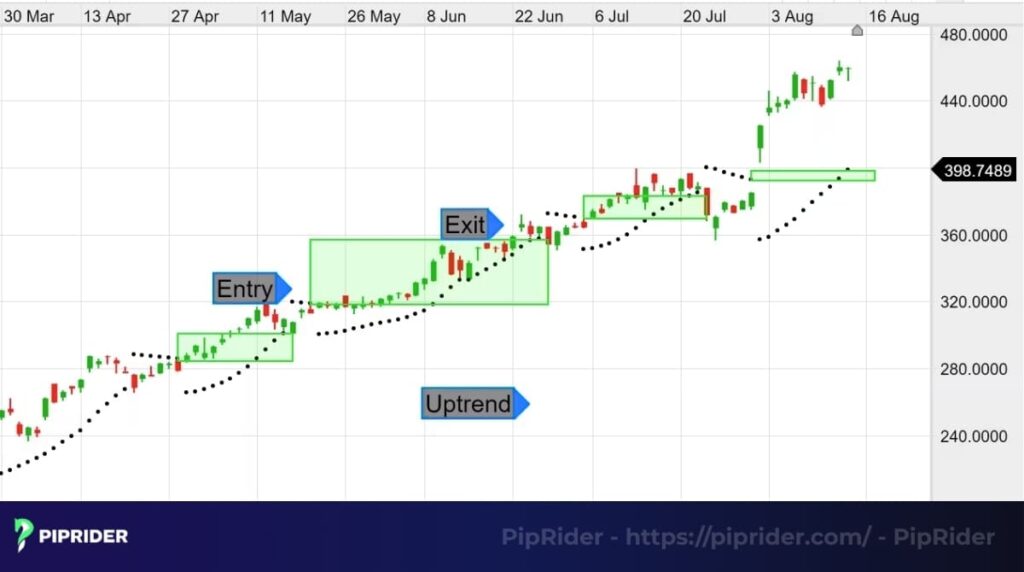
PIPRIDER’S TIP:
One of the biggest mistakes we made as a new trader was to blindly follow every single flip. In a sideways or “choppy” market, the dots will flip back and forth constantly, generating many false signals and leading to small, frustrating losses. The indicator’s signals are most reliable when a clear trend is already forming. Always use it as a confirmation tool, not a crystal ball.
3. How is the parabolic SAR calculated?
While you don’t need to be a mathematician to use this indicator, understanding its calculation gives you a much deeper appreciation for its behavior on the chart. Think of it like looking under the hood of a car – you don’t need to know how to build the engine, but knowing what the main parts do helps you drive better.
The calculation essentially asks two questions at every step:
- Has the price reached a new extreme in the direction of the trend?
- Based on that, how much closer should the SAR marker move to the price?
The formula might look intimidating at first, but it’s built from just a few key components.
3.1. The core formulas
There are two key formulas to understand: one for identifying an uptrend and another for a downtrend.
- For a Rising Trend (Uptrend):
New SAR = Prior SAR + [AF * (EP – Prior SAR)] - For a Falling Trend (Downtrend):
New SAR = Prior SAR – [AF * (Prior SAR – EP)]
These formulas are driven by two critical variables: the Extreme Point (EP) and the Acceleration Factor (AF). Let’s break those down to understand the key components:
- Extreme Point (EP): This tracks a trend’s most significant high or low.
- In an uptrend, EP follows the highest high
- In a downtrend, it is the lowest point. The indicator updates this value whenever the price makes a new high or low.
- Acceleration Factor: This is the crucial element that makes the tool effective. It controls how quickly the SAR marker accelerates towards the price.
- It starts at a default value, typically 0.02.
- Each time a new EP is recorded, the AF increases by a “step,” which is also typically 0.02.
- The acceleration factor has a maximum value, usually capped at 0.20, to prevent it from moving too fast.
From our view, the AF acts as the indicator’s sensitivity level or “sensitivity” knob. A low acceleration factor makes the SAR follow the price from a greater distance, making it less prone to incorrect signals in a slow-moving trend. A higher value makes it stick much closer, allowing it to react faster to reversals but also increasing the risk of false signals.
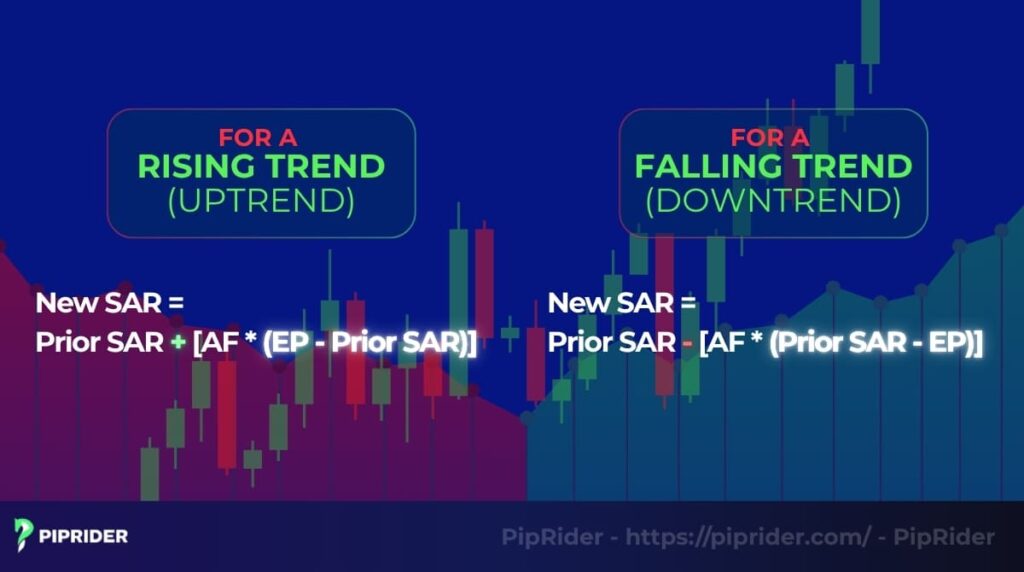
3.2. A simple calculation example
To see the formula in action, let’s walk through a hypothetical uptrend over three days. The key is to remember that the SAR value for today is always calculated using the data from yesterday.
Assumptions:
- Initial/Step Value: 0.02
- Maximum Value: 0.20
Here is how the values evolve:
| Day | High Price | Extreme Point (EP) | Acceleration Value | Calculated SAR for the Day |
| 1 | $42.50 | $42.50 | 0.02 (Initial) | $40.00 (Previous swing low) |
| 2 | $44.00 | $44.00 (New high) | 0.04 (Increased) | $40.05 |
| 3 | $46.00 | $46.00 (New high) | 0.06 (Increased) | $40.128 |
How to read the table:
- Day 1: The trend begins. The SAR is placed at the most recent low ($40.00). The high of the day sets the first EP ($42.50).
- Day 2: The SAR for Day 2 is calculated using Day 1’s data: $40.00 + [0.02 * ($42.50 – $40.00)] = $40.05. Because the price made a new high ($44.00), the EP is updated, and the AF increases to 0.04.
- Day 3: This process repeats. The SAR for Day 3 is now calculated using Day 2’s updated values.
This iterative process continues, with the SAR marker moving closer to the price as the trend accelerates. If the price fails to make a new high and drops below the calculated SAR marker, the “Stop and Reverse” occurs, the indicator flips, and the calculation switches to the downtrend formula.
4. Best Parabolic SAR settings and parameters
If you’ve loaded the Parabolic SAR onto your trading platform, you’ve likely noticed it comes with pre-set numbers. While these default settings are a fantastic starting point, they are not a one-size-fits-all solution. The “best” settings depend heavily on the asset you are trading, the current market conditions, and your chosen timeframe.
Think of it like tuning a guitar. The standard tuning works for most songs, but a skilled musician will adjust the tuning to create a specific sound or to play a particular piece better. Adjusting the SAR’s parameters is your way of tuning the indicator to the market’s unique rhythm.
4.1. Understanding the default settings (Start: 0.02, step: 0.02, max: 0.2)
On most trading platforms like MT4 or TradingView, the standard settings are:
- Start (Initial AF): 0.02
- Increment (Step): 0.02
- Maximum (Max AF): 0.20

They were designed to be a balanced configuration. In our experience, these default settings work remarkably well for swing trading on daily charts, as they are sensitive enough to catch major trend shifts without being overly reactive to minor market noise. For beginners, we always recommend starting with these settings to get a feel for how the indicator behaves.
4.2. Adjusting settings for different markets
The true skill comes in adapting the indicator to what the market is doing right now.
For Fast-Moving, Strongly Trending Markets
When a market is in a powerful, sustained trend, the price moves quickly.
- The problem: The default SAR can sometimes lag too far behind the price, causing you to give back a significant portion of your profits before it signals an exit.
- The solution: You need a more sensitive or “tighter” setting. By increasing the AF value, you make the SAR markers stick closer to the price.
- Example adjustment: You could try changing the Increment (Step) to 0.03 and the Maximum to 0.30.
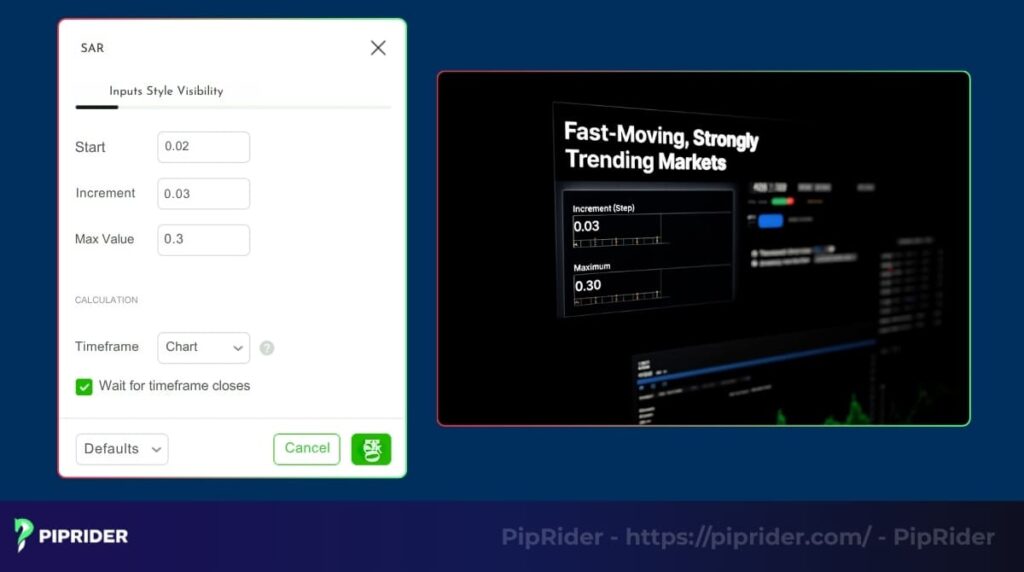
When we’ve traded volatile pairs like Gold (XAU/USD) during a strong rally, we’ve noticed the default settings leave too much on the table. By tightening the SAR, we can secure profit targets more effectively. The trade-off is an increased risk of being stopped out by a sharp but temporary pullback.
For Slower, Less Volatile Markets exit
In markets that are trending but doing so slowly and with frequent, shallow pullbacks, the default settings can be too aggressive.
- The problem: The default SAR will flip back and forth too often, generating numerous incorrect signals.
- The solution: You need a less sensitive or “looser” setting. By decreasing the AF, you give the price more room to breathe.
- Example adjustment: Consider lowering the Increment (Step) to 0.01 and keeping the Maximum at 0.20, or even reducing it to 0.15.

Our advice here is blunt: if the market is truly sideways, avoid this indicator entirely. However, for slow-moving trends, making the indicator less sensitive helps you stay with the primary trend and ride through the minor noise without getting shaken out prematurely.
The importance of time frame optimization
This is an essential idea that numerous traders tend to miss. The optimal setting is directly related to the chart’s timeframe.
- Higher Timeframes (H4, Daily, Weekly): On these charts, trends are more established and market noise is filtered out. The default settings (0.02, 0.2) are generally very effective here. The large-scale trends they identify are more reliable. Our swing trading strategy relies almost exclusively on the default SAR on the daily chart for this very reason.
- Lower Timeframes (M1, M5, M15): These charts are filled with noise. Trends are shorter and reverse more frequently. The default settings are often too reactive here. We’ve found that when attempting short-term scalping strategies, you almost always need to make the SAR less sensitive (e.g., Step 0.01, Max 0.10) to avoid getting stopped out on every minor fluctuation. The goal is to capture the “mini-trend” within the session, not every single price tick.
A word of caution: While technically possible, using this tool for scalping on very low timeframes is an advanced technique and is generally not recommended for beginners. The market noise is extreme, and bad signals are common, even with adjusted settings. You should master the indicator on higher timeframes like H4 or Daily first.
Ultimately, there is no single “magic” number. The best approach is to try different strategies on a demo account. See how different settings perform on your favorite currency pairs and timeframes. Backtesting your settings is not just a suggestion; it’s a requirement for using this tool effectively.
5. Parabolic SAR trading strategies
With an understanding of the indicator’s function and mechanism, let’s move on to its most important application: informing trading decisions. While powerful, successful traders rarely use the tool in isolation. Top strategies involve combining its signals with other tools for trend confirmation, ensuring your trades are with the trend, not against it.
From our own experience, relying solely on the indicator’s “flips” for entries and exits is a recipe for disaster in choppy markets. Where it truly shines is as a core component of a well-rounded trading system. Let’s explore a few effective strategies.
Strategy 1: Basic entry and exit signals
This is the most direct way to use the indicator, best suited for markets that are clearly trending.
Buy Signal (Entry):
- Keep a close watch on the market for signs of a downtrend, which is shown when the markers rise above the price.
- Focus on the “flip” – that critical moment when the first point falls below the price candle. This flip should be confirmed by bullish candlestick patterns.
- Once you spot this, confidently enter a long (buy) position at the start of the next candle.
- Place an initial stop-loss just below the recent swing low.
Sell Signal (Entry):
- Monitor the market until it shows an upward trend, indicated by the markers being below the price.
- Identify the “flip” – the moment the first point appears above the price candle.
- Enter a short (sell) position on the opening of the next candle. Many traders use stop orders to automate this entry.
- Place an initial stop-loss just above the recent swing high.
Exit Signal (Using the SAR as a Trailing Stop):
The Parabolic SAR’s most valuable role is serving as an automated exit strategy. Think of its dots as a set of guardrails for your profits.
- In a long entry, these markers rise with the market’s ascent, providing a dynamic safety net. Your exit is triggered the moment momentum reverses and price crosses below one of these protective dots.
- Conversely, in a short entry, the dots fall with the market, serving as an ever-tightening stop. A sudden price spike that breaches a dot to the upside is your cue to close out.
This clear-cut method eliminates guesswork and emotions, allowing you to ride a trend while securing your gains.
Strategy 2: The trend-following filter strategy
This is a more robust approach that dramatically improves the quality of your signals by adding a long-term trend filter, such as a moving average.
The Tools:
- Parabolic SAR (default settings: 0.02, 0.20)
- 200-period Exponential Moving Average (200 EMA)
The Logic: The 200 EMA acts as our “master” trend indicator. We only execute trades aligned with the 200 EMA.
Rule for Buy Signals:
- The price must be positioned above the 200 EMA to confirm a bullish market sentiment.
- Only seek buy signals from the indicator, waiting for its markers to flip from above the current price to below it.
- All sell signals should be ignored, as they are likely just pullbacks within a larger uptrend. A multi-moving average setup can provide further trend confirmation.
Rule for Sell Signals:
- The price must be trading below the 200 EMA. This confirms the overall market sentiment is bearish.
- Only look for sell signals from the indicator. Wait for the SAR markers to flip from below the price to above it.
- Ignore all buy signals as these are likely minor bounces in a larger downtrend.
Case Study: The 230-Pip EUR/USD Trade
Let’s put this into a real-world example from the EUR/USD daily chart in late 2020.
- The context: As of November 2020, market price traded firmly above the 200 EMA, confirming a strong, long-term uptrend. Our bias remained strictly bullish, seeking only buy opportunities.
- The signal: After a shallow pullback mid-month, the trend resumed its upward climb. On November 25, 2020, the indicator flipped from being above the candles’ value to below it, providing a clear buy cue. We opened a long position at the next candle’s opening, around 1.1920.
- Trade management: Our position is held through December. Minor dips occurred, yet the price never touched rising SAR markers under it. This allowed confident trade management, with the trailing stop automatically advancing daily to lock in profits.
- The exit: Momentum faded early the following year. On January 12, 2021, the value finally dropped, touching a SAR marker. This served as our objective, pre-defined exit cue. We closed the trade at approximately 1.2150.

The Result: As you can see on the chart above, this trade captured a movement of 230 pips. This case perfectly illustrates how the 200 EMA provided the confidence to stay with the master trend, while the SAR provided a disciplined and highly profitable exit points without any emotional guesswork.
Strategy 3: The Parabolic SAR and ADX combination
This powerful strategy enhances Wilder’s approach by incorporating the Average Directional Index (ADX), effectively addressing the SAR’s primary limitation in ranging markets.
- The Tools:
- Parabolic SAR
- ADX (typically with a setting of 14)
- The Logic: The ADX assesses how strong a trend is, but it doesn’t indicate its direction. It is our “market condition” filter.
- ADX Reading > 25: confirms a powerful market trend. When prices move decisively, SAR signals become highly reliable, allowing you to confidently trade those flips.
- ADX Reading < 25: suggests a weak or non-existent trend. The market is likely ranging, and the indicator’s cues are unreliable, often leading to losses.
- The Trading Rule:
- Check the ADX indicator first.
- If the ADX is above 25, proceed to look for Parabolic SAR entry signals (buy or sell flips) as you normally would, sometimes using automated stop orders.
- When the ADX dips below 25, it’s wise to hold off on trading. Sit on your hands and wait for the market to show a clear direction.

This combination effectively tells you when to use the indicator. Think of it as a traffic signal for your trading: an ADX above 25 means go, while anything below 25 signals stop. This simple filter has saved me from countless losing trades in choppy situations.
6. Advantages and Disadvantages of Parabolic SAR
No technical indicator is perfect, and this one is no exception. Understanding its pros and cons is essential for using it effectively and knowing when to trust its signals – and, more importantly, when to be skeptical. Based on years of using this tool, we’ve found its benefits are powerful, but its weaknesses can be costly if ignored.

The Parabolic SAR is highly valued by traders for its powerful and straightforward benefits:
- Clear trend identification: Its visual markers provide an unambiguous, at-a-glance signal of the market’s direction. The “flip” of the markers offers an objective cue that a trend reversal may be happening.
- Built-in trailing stop: This is arguably its most valuable feature. It automatically provides a dynamic stop-loss that trails the price, helping to protect profits and enforce a disciplined exit strategy without guesswork.
- Simplicity and ease of use: Unlike more complex tools, its marker-based system is incredibly intuitive and easy for beginners to understand, reducing analysis paralysis and allowing for quicker decision-making.
However, it’s crucial to be aware of its potential drawbacks to avoid common trading traps:
- Poor performance in sideways markets: This is its main flaw. In non-trending, choppy conditions, it generates frequent incorrect signals (a whipsaw), which can lead to a series of frustrating, small losses.
- Lagging nature: The SAR is reactive; it confirms a trend only after it has already begun. This means you will not enter at the absolute bottom or exit at the absolute top of a price move.
- Risk of premature exits: The accelerating nature of the markers can sometimes cause them to move too close to the price during a sharp but temporary pullback, stopping you out of an otherwise valid trend too early.
7. FAQ about the parabolic SAR indicator
Here are some of the most common questions traders have when they first start using the Parabolic SAR. I’ve provided direct, experience-based answers to help clear up any lingering doubts and provide clarity on its practical application.
8. Summary
The parabolic SAR indicator is a uniquely powerful and visual tool that serves two critical functions for a trader: identifying the direction of a trend and providing a disciplined, automated method for managing a trade. By placing a simple series of markers on your chart, you remove much of the guesswork and emotion, offering clear signals for potential reversals and, most importantly, acting as a dynamic trailing stop to protect your hard-earned profits.
While its signals are clear, its effectiveness is ultimately tied to the market’s behavior. To truly leverage its power, you must remember its limitations and use it as part of a complete trading system, not as a standalone solution.
Here are the key points to remember from this guide:
- Read the Markers: Markers below the price signal an uptrend; markers above the price signal a downtrend. The “flip” from one side to the other is your primary reversal signal.
- Embrace the Trailing Stop: Its most valuable function is as an automatic trailing stop-loss. Let it guide your exit to lock in profits and prevent giving them back.
- Avoid Sideways Markets: The indicator’s biggest weakness is generating incorrect signals in non-trending, choppy markets. Always identify the market condition first.
- Always Use Confirmation: For higher accuracy, combine the Parabolic SAR with a trend filter like long-term moving averages or a trend-strength indicator like the ADX.
Mastering the Parabolic SAR is a significant step in your trading journey. Here at PipRider, we are committed to helping you build a solid foundation of technical knowledge. Continue to explore our complete library of the best technical indicators to discover more tools that can enhance your strategy. Take the principles from this guide, test them patiently, and start trading with more confidence and clarity.


